CLICK HERE FOR SPEEDMASTER125.COM AND SPEEDMASTER ONLY
The commonly accepted facts about the Speedmaster 125 (ref. 378.081 ST / 178.0002 ST) as we know them are as follows:
• It was issued to commemorate the company’s 125th anniversary in 1973
• It contained the world’s first chronometer-rated self-winding chronograph movement
• It’s case, bracelet, dial, and movement are exclusive to this model, and were not used on any other watches before or since
• Omega’s official stance is that the Speedmaster 125 is a limited edition and there were only 2,000 pieces made
• Certain examples have an alphanumeric code on the caseback, bust most do not
Collectors generally accept these facts, while also noticing that this watch, released over 40 years ago, is quite easily attainable on the secondary market. There are dozens available at any given time, which seems strange for a watch that old and made in such low numbers, but most people chalk that up to a general undesirability due to the size and weight.
I personally find the Speedmaster 125 endlessly fascinating. The more I study it, the more mysterious it becomes. I’d like to share some of what I’ve observed and take on some of the unanswered questions that a deep investigation into this piece of Omega’s history brings up. Remember, these questions are unanswered so there may be some ambiguity in my text.
My Observations
I started collecting serial numbers by reference for all the cal. 1040 watches as well as the Speedmaster 125 with the goal of establishing serial number ranges. Serial number ranges by reference have proven difficult and have taken a backseat to some other “questions” this data can help answer. For example, I can extrapolate production estimates from this data. Over time, I’ve started to document manufacturing date (when an Extract of the Archives is present), original sale date (from old warranty paperwork) and dial variant. Here’s a quick look at my tracking spreadsheet filtered for cal. 1041:
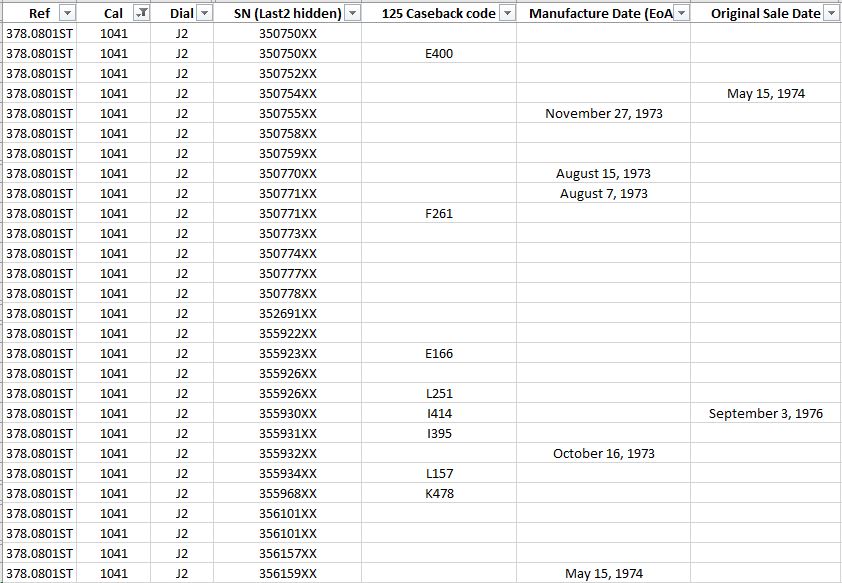
This sheet tracks every unique serial number I have seen for cal. 1040 and 1041. In addition, I maintain a separate list of the unique caseback codes I have seen for Speedmaster 125s. A separate list is needed because often a watch is listed without photos of the movement or inside of the caseback.
For me, the ideal data point for a Speedmaster 125 would be an example with the full serial number, and Extract of the Archives, and a caseback code. Sales date is interesting but I don’t consider it essential or even reliable as it can be filled in by the owner at a later date. Unfortunately, I don’t have any examples with all three (serial, manufacture date and caseback code). Here’s a Venn Diagram illustrating the data points I do have:
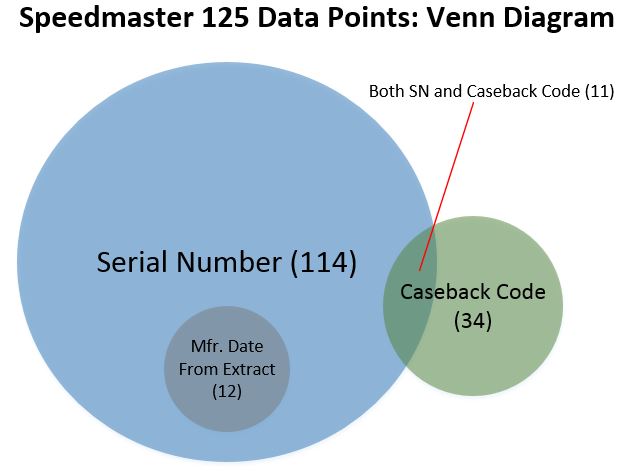
I have 114 serial number observations, including 12 with Extracts of the Archives and 11 with alphanumeric caseback codes. I also have 23 additional caseback codes for which I do not have the corresponding serial number. Not included in this diagram are the 495 cal. 1040 serials I have observed, but we’ll use them later as a reference point.
Let’s have a look at what this data says about the unanswered questions I mentioned earlier…
What Do Those Codes On The Caseback Mean?
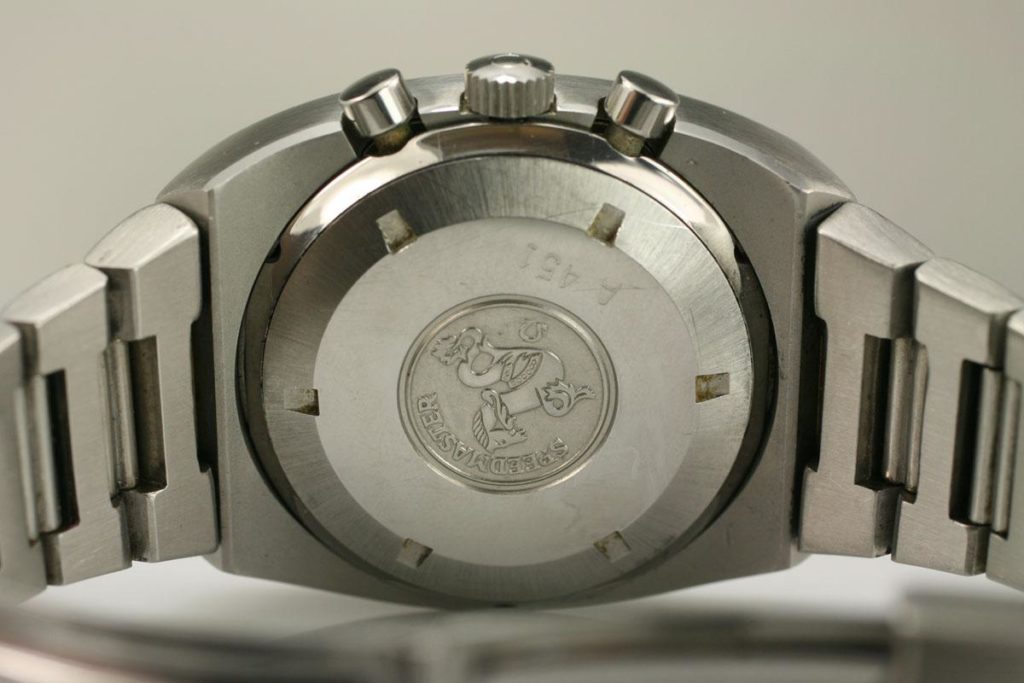
Theory: Sequential Numbering
Chuck Maddox emailed Omega and received a response stating “if your personal timepiece has a number “1308” this logically means that you own the n° 1308/2000.” Chuck seemed to interpret this to imply that his (I 30X) was number 130X / 2000 and that other examples that lack the caseback code “probably have had the inscription worn off via normal use, or possibly had the case back exchanged at some point.”
The email from Omega is an inaccurate answer, since the codes are formatted as a letter preceding a three digit number. And Chuck’s explanation for the examples without the code makes sense until you start factoring in serial numbers and extract data. Hang with me, we’ll get there!
Theory: Five (or Nine?) Batches of 400 Watches
The theory goes that there were five batches of 400 watches, lettered A, B, C, D, or E followed by a number from 1-400. Another version says there were nine batches of 400 lettered A through I.
The five batch theory is rooted in the description of an auction lot from the 2007 Omegamania auction. Per Omega Forums user webvan, the description of a Speedmaster 125 Lot 217 reads “launched in 1973, was produced in a limited edition of 2000 examples. Production was divided into 5 groups of 400 watches each. The watches bore an individual number, i.e. “E 400”. The letters A through E designated the group, while the number indicated the watch’s position within the group. These numbers were very lightly engraved and have a tendency to disappear during servicing or with wear. The present watch, bearing the number “E 400” is therefore the last “Speedy 125″ to be produced”.
So Antiquorum went to lengths to hype this piece, but I strongly disagree with the premise of this watch being the last Speedy 125. The serial number of 35075079 suggests it might actually be among the earliest Speedmaster 125s. Plus, the most obvious reason is that I’ve seen Speedmaster 125s with codes starting with F, G, I, K and L.
The nine batch theory has a similar premise, but extends the numbered production to 3,600 in batches of 400 starting with A through I. This theory is found in a German language forum thread from 2009. I don’t speak German so I used Google Translate. The author reached many of the same conclusions I have (only several years earlier than I did!) based on some of the same evidence. The 9 batch theory has a similar problem to the five batch theory, since I’ve seen letters beyond I. Another problem with both theories is that I’ve seen numbers higher than 400. I have not observed any higher than 493 though.
Theory: Letters Identifying a Country or Region
It has also been suggested that the letters represent a country or region the watch was delivered to. This seems like something Omega would have tracked. Their warranty cards have long included a country code and they still do. Extracts also mention the country of delivery.
Regardless of why, the fact remains some watches have the code, others don’t. The codes I’ve seen, and the frequency I’ve seen them:
Why Don’t All Speedmaster 125s Have A Code?
Remember earlier, Chuck Maddox wrote that the 125s without a caseback code “probably have had the inscription worn off via normal use, or possibly had the case back exchanged at some point.” Certainly possible but when you take into account serial numbers there’s a strong correlation between serial number range and the presence/lack of alphanumeric code. Most of us now believe in a hybrid of the 5/9 batch theory: that there were some numbered pieces early on that were separated into lettered batches, and later the numbering was abandoned. The data supports this. Why they did this is speculative.
One school of thought is that Omega had intended to release 2,000 numbered units and these are the ones with the alphanumeric code. The later pieces were unnumbered, and have no code. This theory is helpful for attaching credibility to the official Omega count of 2,000. The other school of thought is that there are more than 2,000 numbered pieces and the numbering system was abandoned for some reason.
Do All The Lower Serial Number 125s Have A Code?
I don’t know. I started observing serial numbers before I started tracking the codes so I may have missed some. However it is pretty obvious that the prevalence of a code is much greater in the earlier batches.
First, let’s look at the distribution of all Speedmaster 125s regardless of whether they have an alphanumeric code by serial number “batch”, where batch means first four digits:
Notice that there are major batches at 3507, 3625-3626 and 3828-3829, and minor batches at 3559 and 3561. There are a few other random serials outside of these batches. Now let’s look at the eleven data points where I have both the serial and the code:
Speedmaster 125 - SN and Code
Note that all of the examples with a code are in the 3507 or 3559 batches. Generally speaking, serial number increases over time. So it is easy to conclude that the codes occurred earlier in the lifespan of cal. 1041.
Exactly one third of my serial number observations fall in the two batches that have been observed with alphanumeric caseback codes. Further confusing things is my Speedmaster 125, which doesn’t have an alphanumeric code but is an early example (3507 serial) with the earliest manufacture date I’ve seen so far. Is my caseback a service part? Was the code worn off through wear over time? Did it ever have a caseback code? I don’t know the answer to these questions either (although my caseback certainly appears original, unpolished, and period correct). These beg the larger question:
Does Omega Have Records on the Alphanumeric Codes?
If I were to send them my serial number, would they be able to tell me if it ever had a code and if so what my code was? Only Omega can tell us that.
When Were Speedmaster 125s Produced?
This reference is nearly always cited as a 1973 watch, which is understandable since that is the year Omega celebrated its 125th anniversary. But Omega made these over four calendar years – well into 1976 – based on data from archive extracts. As you can see, the production is mostly in the order you’d expect based on serial number.
The chart above counts month of production with January 1973 being month 1, February 1972 = month 2, and so on. The data is not perfectly linear, but is directionally what we’d expect.
Speedmaster 125 Production Dates
Where Did The Production Figure Of 2,000 Originate, And When?
This is a complicated question. Omega used the words “limited” and “commemorative” but they did not initially say exactly how many were made. The 2,000 figure was possibly added later. Let’s examine some of the typical sources of vintage Omega information and see whether they mention 2,000 pieces or not.
Omega’s Website
Many collectors start with the Omega Vintage Database. Searching for “378.0801” was the only way I was able to get the Speedmaster 125 to come up, and its page made no mention of the 125th anniversary, the number made, or even that it was a chronometer. I’ve written before about what a disappointing entry this is.
More recently, Omega put together an online presentation for the 60th anniversary of the Speedmaster family in 2017, which included the Speedmaster 125. The text on the Speedmaster 125 states “This model was the world’s first automatic chronograph to receive an official Chronometer Certification. It was released to celebrate the founding of the OMEGA brand in 1848 and 2,000 pieces were produced to mark the occasion.”
Omega’s Museum
As I pointed out earlier, Chuck Maddox had a response back in 2000 from the museum that stated there were 2,000 pieces made and the numbers were sequential. We know that cannot be correct. Marco Richon, then the curator of the Omega Museum, responded to a collector’s inquiry confirming the 2,000 total back in 2006. I’m not aware of any further statement from the Museum in the past decade.
Speedmaster 125 in Books
A Journey Through Time (Marco Richon, 2007) cites the production of 2,000 in multiple places, but also includes several period ads that do not mention this total. I’ve written before about the inaccuracies in this book.
Omega Designs (Anton Kruezer, 1996) mentions the Speedmaster 125 in some detail, including the commemoration of 125 years in 1973, but makes no mention of a production total. Perhaps the number 2,000 started circulating sometime after 1996 and before Chuck Maddox’s 2000 article.

The other Omega books I own don’t mention the Speedmaster 125, except for the 2017 updated edition of Moonwatch Only (Marquie, Rossier), which briefly covers the Speedmaster 125 and cites the 2,000 production total.
Extracts of the Archives
[UPDATE, August 2017: A recent Extract was discovered that no longer makes reference to a production total of 2,000. See here for more]
Extracts for Speedmaster 125s mention that it is limited to 2,000 examples, but make no mention of the alphanumeric code. Remember also that these documents were produced in the past 15 years or so. Here is my Speedy 125 and Extract:
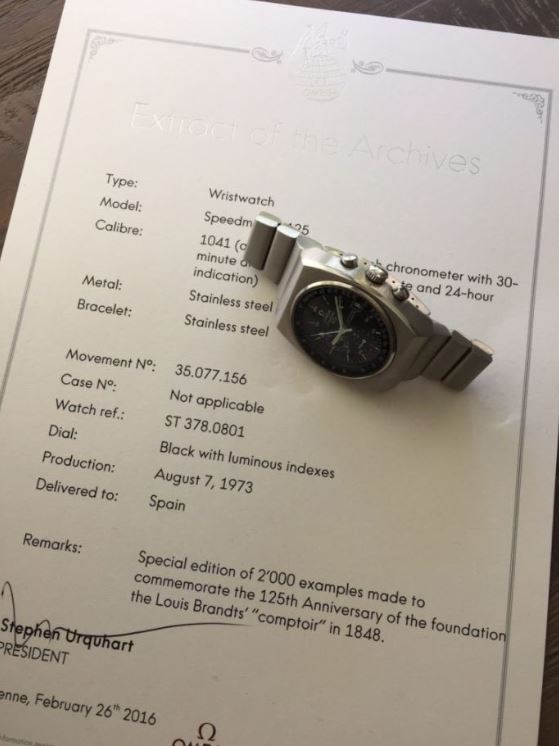
The Alphanumeric Code Stamped on a Card
I’ve seen the following example of a card that came with a Speedmaster 125, and the number on the caseback matched the stamp:
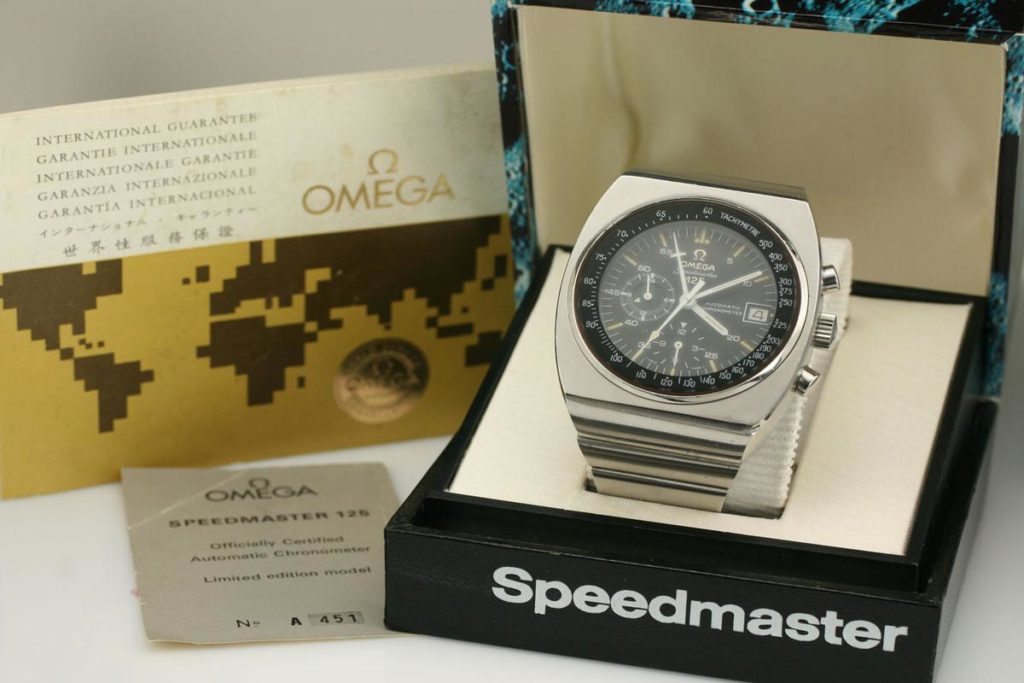
The card clearly says “Limited edition model”, but doesn’t say how many the edition is limited to.
1975 German Catalog
This document says (roughly translated) “Each model is numbered and therefore especially of interest for collectors”. But again, doesn’t specify a total.
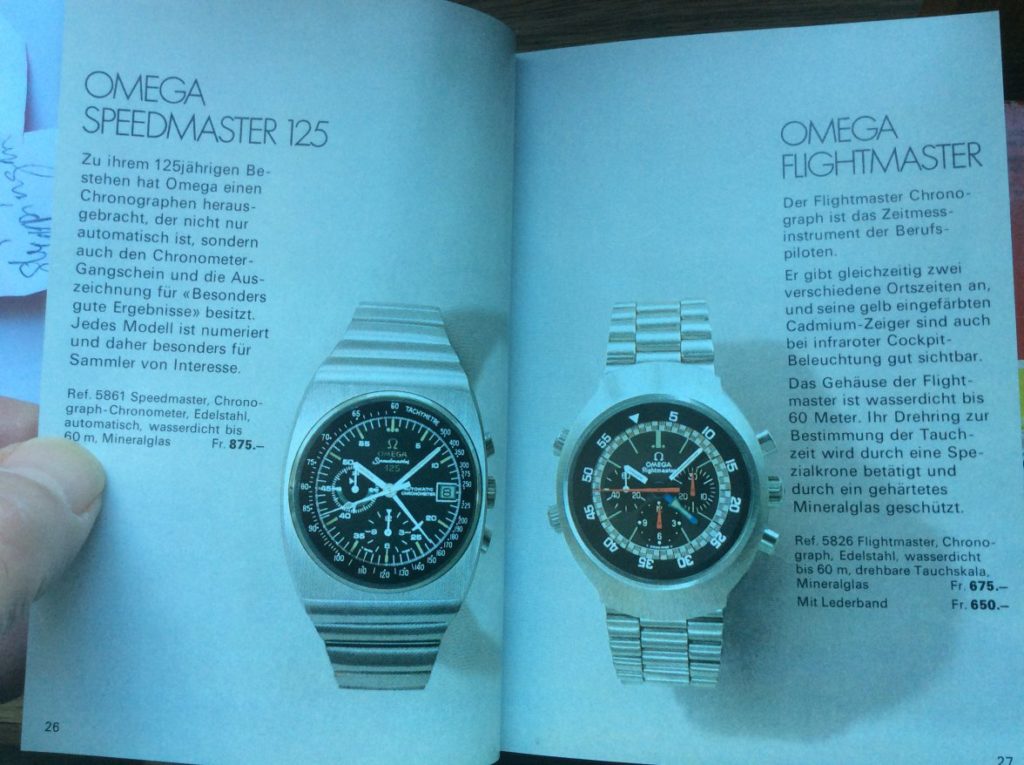
What is interesting is that this catalog is from 1975, which seems from the above evidence to be well past when Omega stopped numbering the cases. Did it take this long to move that older numbered stock, or did Omega just not update all of their marketing materials?
A 1973 Catalog Celebrating 125 Years of Omega
Found on old-omegas.com, this catalog features the Speedmaster 125 on the cover, which it describes as a commemorative limited edition” with no mention of the number available.
Thus far I’m unable to pinpoint the transition from Omega saying it was limited but not to how many to Omega using the number 2,000. As to where the number 2,000 came from, here are a few possibilities:
1. Omega made 2,000 of them, just as they say.
2. Omega made 2,000 numbered pieces and the rest were not numbered or limited.
3. Omega made more than 2,000 and the number 2,000 was just a typo or error that has gained a life of its own.
4. Omega intended to only make 2,000 but thanks to the chaos and financial challenges of the times they made more.
I think 1 is unlikely, but the rest are plausible.
There are other ads and documents on that site, but none give a production total for the Speedmaster 125.
How Many Speedmaster 125s Did Omega Actually Make?
This is a question I think about a lot, and I’ve been over it a few times here on my site and elsewhere. My current estimate is around 19,000. My methodology is broken down here, with more nuance here and here. But for the sake of anyone that doesn’t want to click away from this page, here’s a brief summary of how I’ve arrived at this number:
• A Journey Through Time cites the production of Speedmaster 125 (actually of cal. 1041) as being 2,000. I believe that’s wrong, so I try to compare it to a similar calibre of its era. I use cal. 1040, which I also track.
• AJTT cites the production of cal. 1040 to be 82,200 units. This seems more reasonable.
• My method assumes that the figure for 1040 is correct, and assumes that the figure for 1041 is incorrect. I am fully aware that I’m cherry-picking data from the same source that suits my theory, but bear with me…
• I document every serial number I see. Most data points come from online sales. I check daily and add an average of about 5 points of data per week. I have been documenting all 1040 and 1041 serials during the same period using the same methods. As you can see, I have observed more Speedmaster 125s than any cal. 1040 reference other than 176.007 ST. If 2,000 is the right number of 1041s, I’ve already seen 5.7% of them…
• …so even if AJTT isn’t right about the exact production totals of cal. 1040, I believe my observations reflect a strong approximation of the numbers of these watches relative to each other.
• To make my cal. 1040 production estimates, I just apply the percent of observation of each cal. 1040 reference to 82,200.
• To get a 1041 estimate, I make the assumption that the Speedmaster 125 should appear on the market as frequently as cal. 1040. Yes, there are factors that may affect the “availability” of each reference, including the Speedmaster 125. These factors can impact a reference up or down, so I assume they all cancel out. So if I’ve seen 0.6% of all cal. 1040s produced, I assume that I’ve seen that same percentage of all 1041s, rather than 5.7%.
• That ratio between the 1041 observation percentage (5.7%) and the 1040 observation percentage (.602% as of today) is currently 9.47:1. That basically says that if AJTT is somehow right about both calibres, then the Speedmaster 125 shows up 9.47 more often on the market than cal. 1040 watches.
• My estimate is just the product of that ratio times 2,000.
Here are the current estimates, roll your mouse over each bar for the exact totals.
Pay attention to the last two bars on the right: the shorter one is if Omega is right (2,000), the far right is my estimate. There’s quite a gap between the two. And if you’re familiar with vintage Omegas, compare the height of the 2,000 bar to some of those other references. Do you really think Omega made more 176.001s than Speedmaster 125s? How about Yachting Chronographs (176.010ST)? Just think about how often you see those for sale compared to Speedmaster 125s.
And I just want to stress that my method of tracking unique serials eliminates the possibility that I’m just seeing the same unsellable pieces over and over again.
So I think it is safe to say Omega made more than 2,000 Speedmaster 125s. Maybe not as many as 19,000, but nearly as many as they made of a fairly common reference of that era, the Seamaster 176.007.
Conclusion
The above questions may be unanswered, but I don’t believe they are unanswerable. I think it’s time for the Omega Museum to address these questions, and shed some light on what is an underrated, important and deeply interesting watch from their history. Hopefully someday soon I’ll be writing a follow up article thank Omega for giving answers to many, if not all of these questions.

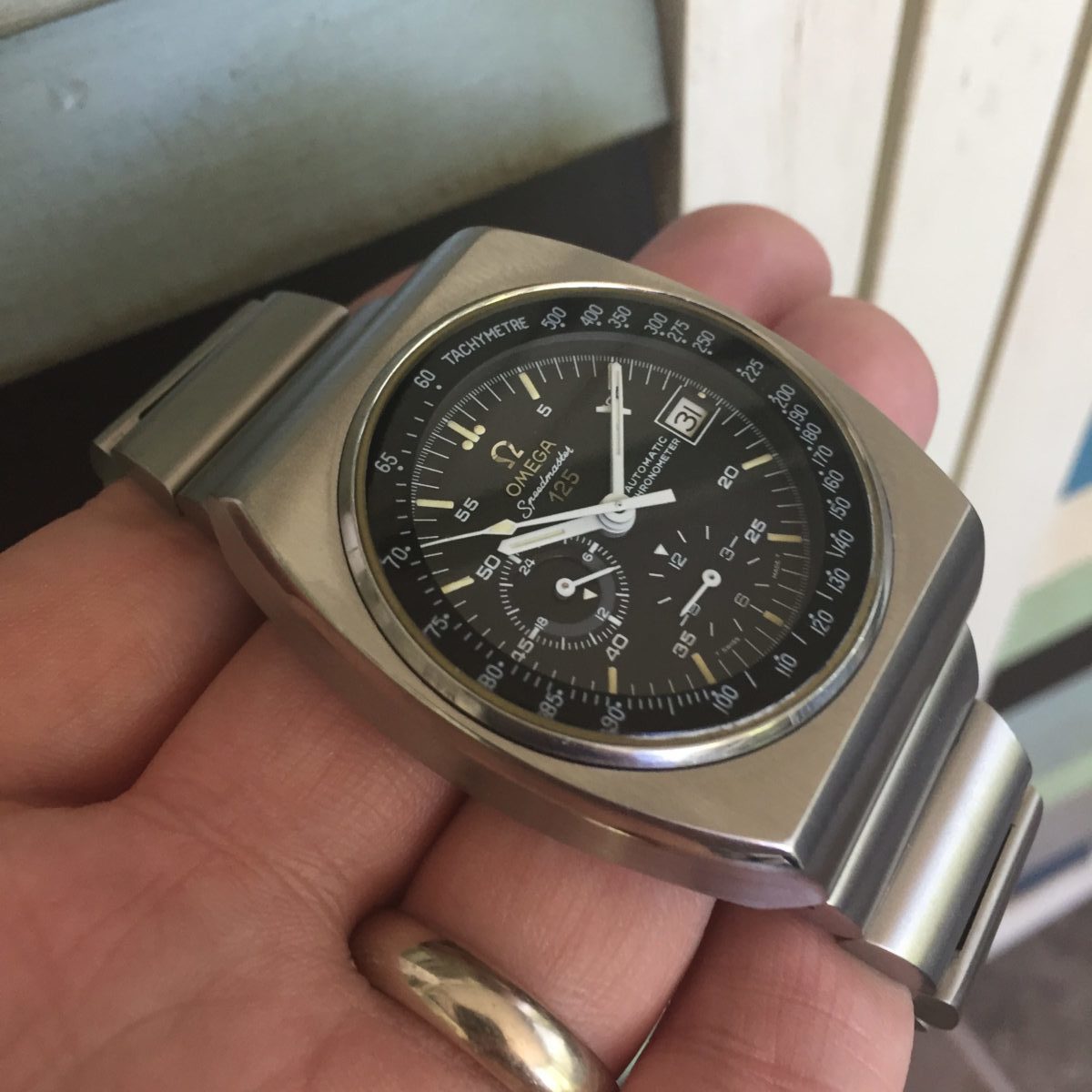
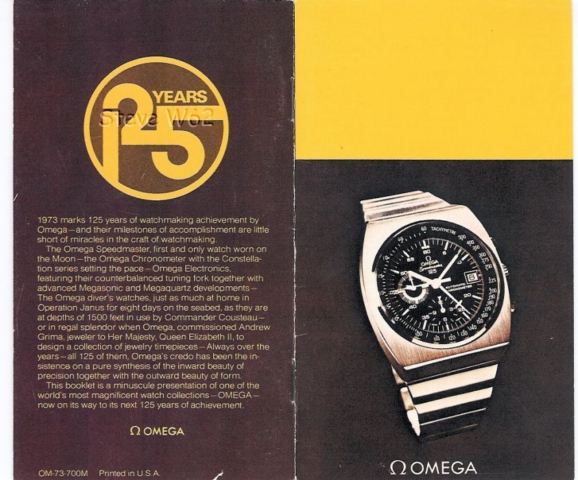
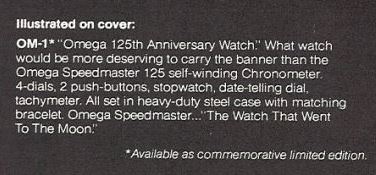
Hi, thanks for sharing all this information, you should have invest a lot of time and thinking to build this article. I have been collecting Omega Speedmaster’s for the last 10 years, and it’s great to have a source of valuable information in your site. Back in the days, other than the great Chuck Maddox the information was harder to find than to find an specific time piece on the market, sometimes I think is the opposite now days.
Regarding your estimate of 19K’s 125s, I carefully read your premise and I understood how you build the numbers. By no means I want to argue with you, because it’s clear that you had spend a lot more time and thinking on this matter. But I would like to share some thoughts on why the quantity of 125s should be lower than 19K:
1.- Unfortunately or not, so far the 125 did not get the attention that it deserve from the collectors community. I concur with the idea that are so many 125s available in the market due not many people like it aesthetically and it is not a good investment due the lack of interest.
2.- The previous point does not apply to other 1040 models like the 176.001, .002 or .007. They have a broader aesthetic acceptance and they were part of the standard product line of Omega in the 70s, so (my guest) they should been produced in the larger quantity than a special edition as the 125s. I think that today’s collectors and vintage seekers are more likely to keep and wear this models rather that a 125.
3- Also on why there are no more offering of those 1040 models is the fact that those watches were more popular models in the 70s and people bought them to use them as a daily beater, so I could guest that it is more likely that more 1040s do not survive the time than a special edition 125.
4.- Regarding the Yachting Chronographs, I think that back in the early 70s the yachting sport was not too popular among the masses so production should be small. Also those who brought them to use to time yachting events, so we could infer that the owner used their watches close or in the water, and the 176.010 did not have a high rate of water proofing, sadly many did not survive.
5.- My last point is price. When the 125 was launched to the market it was more expensive than the regular 1040’s models, between 10 and 20% more (I did not remember the exact number now). From the commercial point of view, to me it does not make to much sense for Omega to build more or as many pieces as the 176.002 or .007, both standard and popular models, with more printed advertising.
Of course a theory is a good as any one, and again for sure you invested more time and thinking that I did. Also as you, I think the 2000 numbers is not exact, but I think this will be kept as one of the greatest mystery on Omega’s history. I love my 125 and I hope the community start to appreciate it more as it deserve.
Thanks for sharing all the information you had made available through your web page. Best regards.
Thanks for the comments and the kind words Alexander! All fair points. I disagree that the .002 is aesthetically more acceptable or wearable, but that’s just a matter of taste. I think these points certainly all could affect the rate at which we see these watches hit the market. And so maybe 19,000 is too high. But even if I’m off by 300%, then Omega still made at least 6,000 125s, which is itself 300% higher than their official total! Hopefully Omega will re-open the book on these sometime soon and settle this for good.
Brilliant work Andy , as mentioned this is now before the Museum and I sincerely hope this gets resolved so that collectors get clarity and you get the recognition you deserve
Best Wishes
Thank, very much appreciated!
Hi ANDY,
First, thank you for all your articles,I read them with great interest
I’m a private collector of vintage OMEGA wristwatches
I do have a Speedy 125 as well
SN 35 593 ***, 378.0801/178.002
with alphanumeric case back :K 134
Stainless steel Omega bracelet 1221/212
the original inner caseback:
A triangle surrounding “Ω OMEGA WATCH CO”
FAB. SUISSE SWISS MADE
ACIER INOXYDABLE
BREVET + 508925
378.0801 178.0002
TYPE A1. INOX IN CENTER
(S/N RANGE: 35.073.XXX – 35.596.XXX)
Outside:
alphanumeric code
Inside:
regular writing
ACIER INOXYDABLE in center
Friendliest regards from Istanbul
Namık DEMIRCIOGLU
Thanks for the data, much appreciated!